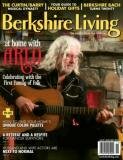THE BEAT GOES ON: Patti Smith
The title of Patti Smith’s fabulous new memoir, Just Kids, is dra wn from a sweet anecdote about a walk she took one day through Washington Square Park with her then-boyfriend, Robert Mapplethorpe. An elderly couple, apparently tourists, spotted the bohemian-looking pair, and the wife said to the husband, “Look at them, do you think they’re artists?” To which the husband replied, “No, they’re not artists. They’re just kids.”
wn from a sweet anecdote about a walk she took one day through Washington Square Park with her then-boyfriend, Robert Mapplethorpe. An elderly couple, apparently tourists, spotted the bohemian-looking pair, and the wife said to the husband, “Look at them, do you think they’re artists?” To which the husband replied, “No, they’re not artists. They’re just kids.”
In many ways, the husband was right, and in large part that is Smith’s point in this vividly rendered remembrance of her early years in New York City, when she and Mapplethorpe had yet to emerge as the household names they eventually would become. It was, in Smith’s recollection, a tough but vibrant time, when, without any post-modern irony or self-consciousness, the duo set out sincerely to become artists. Mapplethorpe’s goal was to be a painter; Smith’s to be a poet. Each, as it turned out, would gain fame in different but related fields—Mapplethorpe’s most penetrating visions would be rendered via the camera; Smith’s poetry would be powered by some of the darkest, most haunting New York-style rock music ever made.
The bulk of Smith’s memoir focuses on the couple’s period of gestation as artists—before Smith would gain fame as the poetess-priestess of punk; before Mapplethorpe would shock the art world with his violent images of sadomasochistic homosexual sex. Smith focuses on the mundane, everyday struggles of these bohemians just trying to get by: the scrounging around for affordable apartments and second-hand furniture; the art of rarely eating; the essential importance of support—material, emotional, and spiritual—that was required in order for Mapplethorpe and Smith to persevere in their belief that they had something to say and were destined for greatness when they found out what it was and how to say it
There is a naive quality in Smith’s portrayal  of these two, neither of whom started out with any great distinction or apparent talents other than their ability to blend into a fertile, downtown New York creative scene at what for each of them turned out to be the perfect time—the late 1960s and early 1970s. Downtown, in Smith’s recollection, was one large playground for artists, poets, and musicians, much of the scene centered at the famed Chelsea Hotel, where the couple wound up living, and where they encountered a “who’s who” of influential characters, including Janis Joplin, Sam Shepard, Jimi Hendrix, Bob Neuwirth, and folk music anthropologist Harry Smith (no relation), who became one of Smith’s guides to a lost world of American folk and blues.
of these two, neither of whom started out with any great distinction or apparent talents other than their ability to blend into a fertile, downtown New York creative scene at what for each of them turned out to be the perfect time—the late 1960s and early 1970s. Downtown, in Smith’s recollection, was one large playground for artists, poets, and musicians, much of the scene centered at the famed Chelsea Hotel, where the couple wound up living, and where they encountered a “who’s who” of influential characters, including Janis Joplin, Sam Shepard, Jimi Hendrix, Bob Neuwirth, and folk music anthropologist Harry Smith (no relation), who became one of Smith’s guides to a lost world of American folk and blues.
In style and a pproach, Smith’s memoir sometimes recalls Bob Dylan’s Chronicles, and although he rarely makes an appearance in her story (that would come later in Smith’s career)—having already bailed from New York in favor of the quieter pastures of Woodstock, N.Y.—Dylan hovers over these proceedings nonetheless as the hero and role model he was for Smith. The scene fed Smith in numerous ways, with independent newspapers she contributed to as a rock critic; with entry-level jobs at bookstores including the famed Scribner’s Bookstore; and with intimate poetry readings with the world’s greatest poets at bookstores such as St. Mark’s, where she rubbed shoulders with latter-day Beat poets Allen Ginsberg and Gregory Corso, among others.
pproach, Smith’s memoir sometimes recalls Bob Dylan’s Chronicles, and although he rarely makes an appearance in her story (that would come later in Smith’s career)—having already bailed from New York in favor of the quieter pastures of Woodstock, N.Y.—Dylan hovers over these proceedings nonetheless as the hero and role model he was for Smith. The scene fed Smith in numerous ways, with independent newspapers she contributed to as a rock critic; with entry-level jobs at bookstores including the famed Scribner’s Bookstore; and with intimate poetry readings with the world’s greatest poets at bookstores such as St. Mark’s, where she rubbed shoulders with latter-day Beat poets Allen Ginsberg and Gregory Corso, among others.
Mapplethorpe and Smith provided each other with the love and fallback support each needed to explore their respective muses and, eventually, relationships outside of their own. From a home base with Smith, Mapplethorpe explored his homosexual leanings and gained entrance to an art scene that would eventually support him, in contrast to Smith’s scraping together her paychecks in order to be able to buy the would-be painter his oils and brushes and, eventually, his rolls of film.
Smith was free to embark on creative and romantic relationships with playwright Sam Shepard—they wrote Cowboy Mouth together in an intense flurry of creativity—and Blue Oyster Cult guitarist Allen Lanier—she’d contribute lyrics and vocals to some of his group’s early works. She also seemingly almost accidentally paired off creatively with fellow rock critic and guitarist Le nny Kaye, who on a whim accompanied her at one of her first poetry readings, thereby establishing the foundation for what would become her unique fusion of post-Beat-inflected poetry and underground rock.
nny Kaye, who on a whim accompanied her at one of her first poetry readings, thereby establishing the foundation for what would become her unique fusion of post-Beat-inflected poetry and underground rock.
One major difference between Smith’s Just Kids and Dylan’s Chronicles, however, is that Smith appears to be a much more honest writer. Dylan’s book—like all his self-referential public efforts—is something of a put-on, in both tone and content, whereas Smith’s comes across as totally sincere. She’s also a better writer, and some descriptions of the New York bohemian scene of the early 1970s nearly leap off the page and grab the reader by the head and shake him:
There were days, rainy gray days, when the streets of Brooklyn were worthy of a photograph, every window the lens of a Leica, the view grainy and immobile. We gathered our colored pencils and sheets of paper and drew like wild, feral children into the night, until, exhausted, we fell into bed. We lay in each other’s arms, still awkward but happy, exchanging breathless kisses into sleep.
Without any overt intention, Smith’s memoir raises some essential questions. Her story—like James Joyce’s before her, her portrait of the artist as a young woman—is one of paying dues over time, of soaking in influences from everywhere—books, films, paintings, for sure, but mostly from other living, breathing, working artists. For both Smith and Mapplethorpe it was a slow evolution on their unique  paths toward their own revolutionary developments. Theirs was a give-and-take with a greater arts scene, centered in cafes and on sidewalks and in nightclubs such as Max’s Kansas City, where Andy Warhol and his coterie still reigned and, where gaining admission to their table was, in no small part, an indication of initial acceptance and success.
paths toward their own revolutionary developments. Theirs was a give-and-take with a greater arts scene, centered in cafes and on sidewalks and in nightclubs such as Max’s Kansas City, where Andy Warhol and his coterie still reigned and, where gaining admission to their table was, in no small part, an indication of initial acceptance and success.
It’s impossible to imagine how any of this could have happened at any other time, in any other place, without a community that inspired and supported (and, at times, infuriated) them—which makes one wonder about the possibility of anything like this happening today. Are there still scenes where artists support and inspire each other, outside of college campuses and virtual communities? In the age of American Idol and YouTube—in a fractured, wired culture where geography means hardly anything and Bohemia is just another stop on the Long Island Railroad—is there any room for artists, in the old-fashioned, romantic sense of the term, to grow organically in the manner of these two beautiful kids? [MAY 2010]
Seth Rogovoy is Berkshire Living’s editor-in-chief and cultural critic. His column, “The Beat Goes On,” is once again a finalist in the General Criticism category of the National City and Regional Magazine Association awards—the fourth time he has been so honored.
THE GOODS
Just Kids
by Patti Smith
Ecco
IMAGES COURTESY PATTI SMITH

 Delicious
Delicious Digg
Digg StumbleUpon
StumbleUpon Propeller
Propeller Reddit
Reddit Magnoliacom
Magnoliacom Newsvine
Newsvine Technorati
Technorati


